

Damion Smy
Boxy new KGM Musso unveiled to take on HiLux and Ranger ahead of Australian launch
7 Hours Ago
The Polestar 2 remains a competitive alternative to a Model 3, though recent price rises and expensive options dull its appeal somewhat.

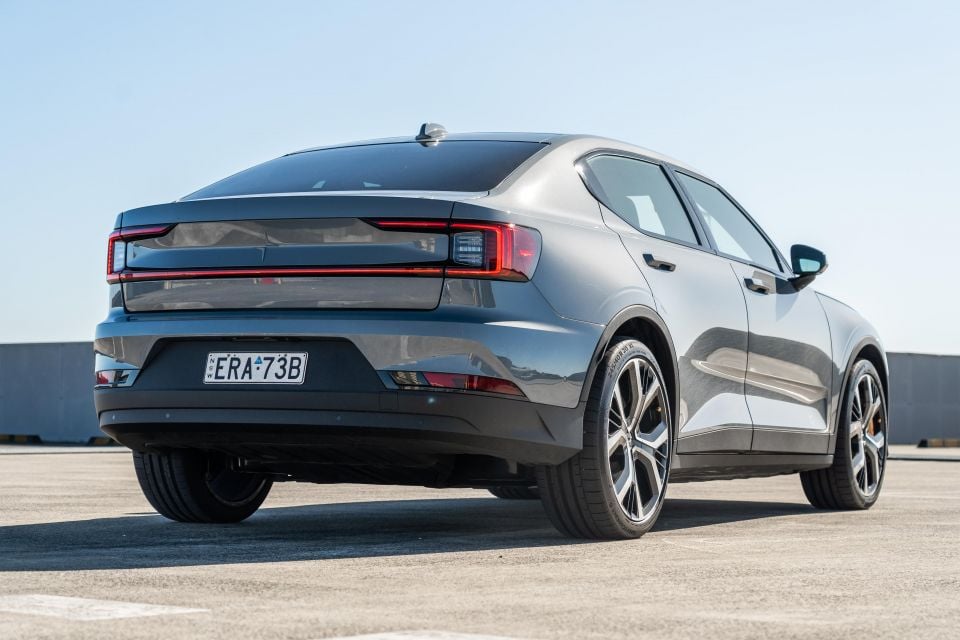

Quickly see how this car stacks up against its competition. Select any benchmark to see more details.
Where expert car reviews meet expert car buying – CarExpert gives you trusted advice, personalised service and real savings on your next new car.
The Volvo S40 may be dead, but it lives on in the Polestar 2.

First previewed as the Volvo Concept 40.2 back in 2016, the jacked-up sedan was initially tipped to be the rebirth of the Volvo S40 sedan alongside the all-new (at the time) XC40 SUV.
Volvo would then go on to move away from smaller passenger segments – killing the V40 hatchback in the process – and a few years later the blocky Concept 40.2 design was adapted to create the Polestar 2.
As its name suggests, the 2 is Polestar’s second vehicle offering, and was the first all-electric product to be launched by the electrified performance subsidiary of Volvo and the Zhejiang Geely Holding Group.
It stays very true to the Concept 40.2 that previewed it, if with some subtle design changes to the front and rear fascias to distinguish it as a Polestar – that said, the Polestar 1 was pretty much a Volvo S90 PHEV with the rear doors chopped off.
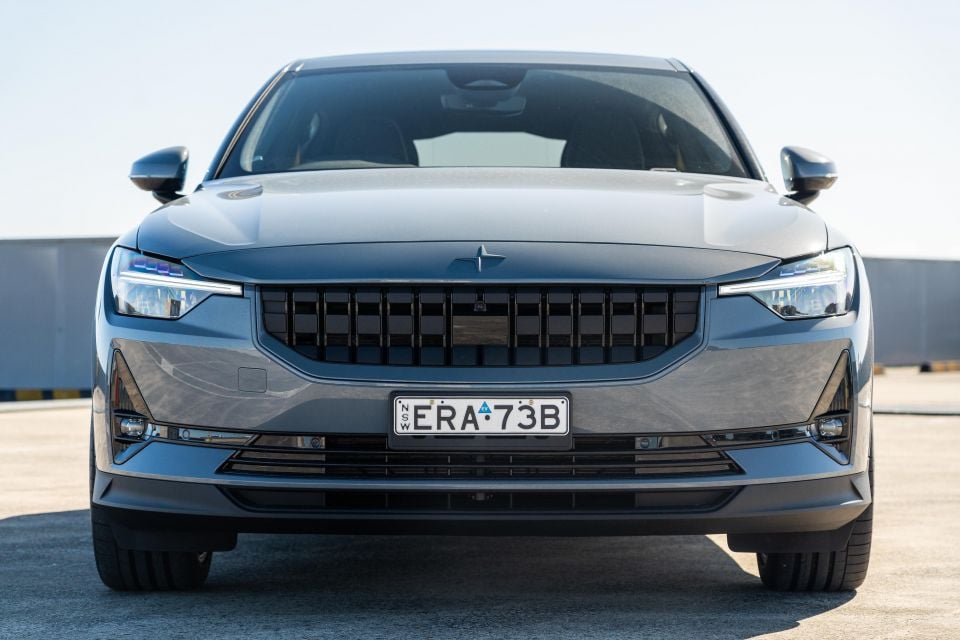
Anyway, I digress. The 2023 Polestar 2 has started arriving in Australia, bringing some subtle changes and price rises to the in-demand Tesla Model 3 competitor.
On test we have the Long Range Dual Motor version, which slots the 300kW twin-motor electric drivetrain from the XC40 Recharge Twin under a lower-slung sedan body, and aims to take the fight to the Model 3 Performance.
Prices are up by $3500 for this variant, and our test car was fitted with just about every option, meaning it’s over $100,000 in your drive-way, at least based on a Melbourne postcode. Is it worth the spend?
Pricing for the 2023 Polestar 2 range kicks off at a relatively attainable $63,900 plus on-road costs, which should also fall under most States’ and Territories’ EV incentive thresholds as well – provided you don’t go wild with options.
However, on test we have the top-spec Long Range Dual Motor (from $73,400) decked out with every available option; including the Pilot Lite Pack ($3400), Plus Pack ($6000) and Performance Pack ($8000), as well as premium paint ($1500). We’ll detail the inclusions a little further down.
All up, the car you see here is a far exxier $92,300 plus on-road costs; which is pricier than the quicker Tesla Model 3 Performance which was recently reduced to $89,900 before on-roads.
It’s also not far off the positioning of the larger and more premium BMW i4 eDrive40 ($99,900); and is in the same ballpark as the also larger Kia EV6 GT-Line AWD ($87,590).
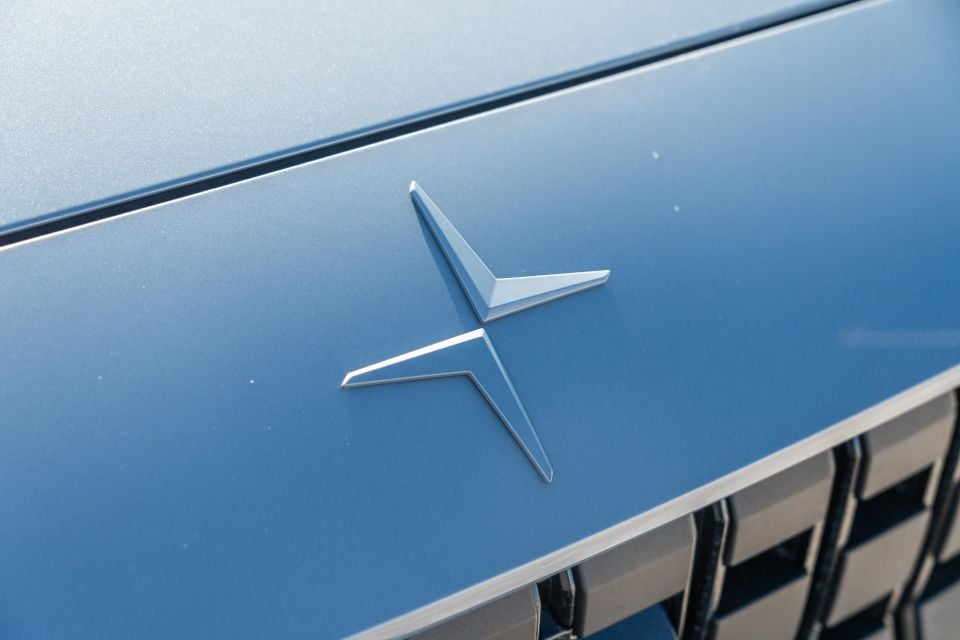
2023 Polestar 2 pricing:
Prices exclude on-road costs
Buy your new car without the stress. It's fast, simple and completely free.

Great service from Travis and team, second time I have used this business would not hesitate to recommend them to anyone
Craig C.
Purchased a Ford Ranger in Sunshine Coast, QLD
CarExpert helped Craig save thousands on his Ford Ranger, now let us save you on your next new car.
Find a dealIf you’ve sat in a Polestar 2 before, not much has changed here.
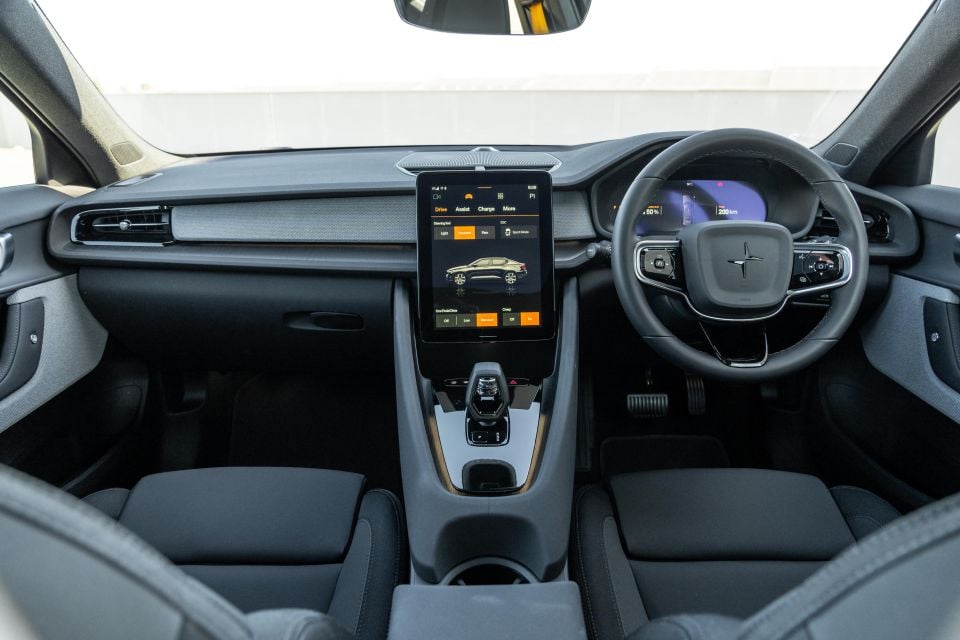
The cabin draws heavily upon the Volvo design and parts catalogue, though the 2 has its own distinct flavour which is also somewhat conventional – if not without its flaws.
Up front there’s a Volvo steering wheel, as well as reskinned versions of the Volvo instrument cluster and infotainment system. Polestar has a very minimalist philosophy across the board, and this is reflected in the interface.
Compared to the related C40 and XC40 Recharges, the Polestar 2 doesn’t offer virtual dials in its instrument cluster; rather settling for just numbers and bar graphs or a pure map display. The infotainment system is very simple in design and layout too, which in most ways is a good thing.
Smartphone mirroring is wired, which can be a little fiddly to set up given the limited storage in the centre console, thought even larger phones fit into the wireless charging slot which doubles as a holder when the phone is hardwired, though the cables don’t really have anywhere to go.
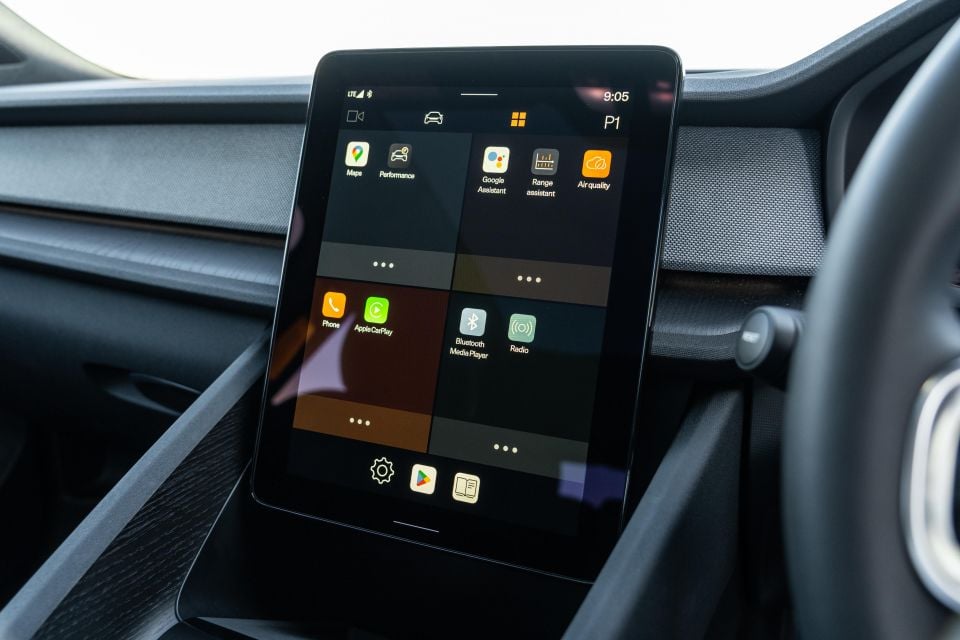
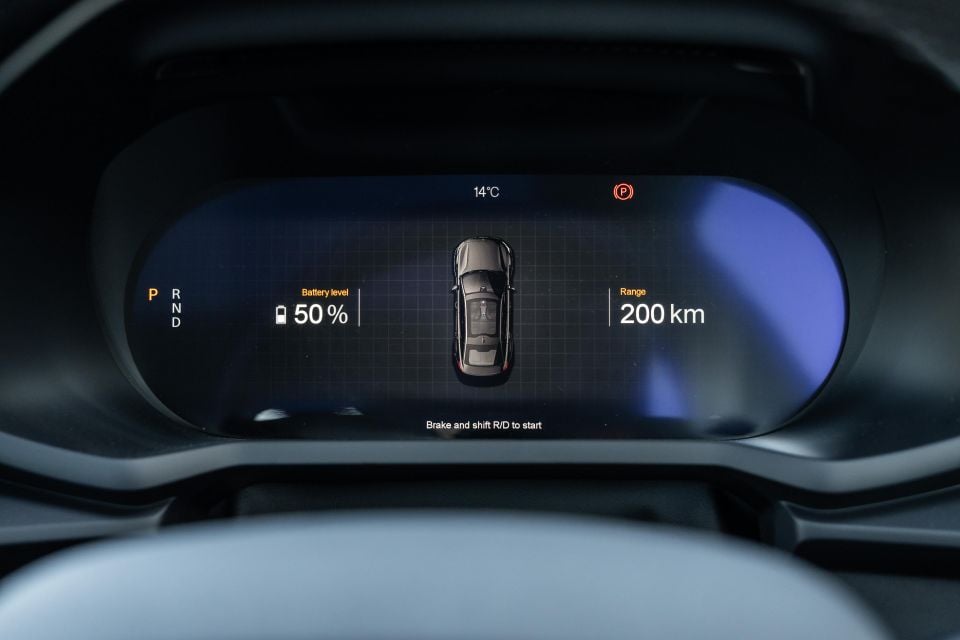
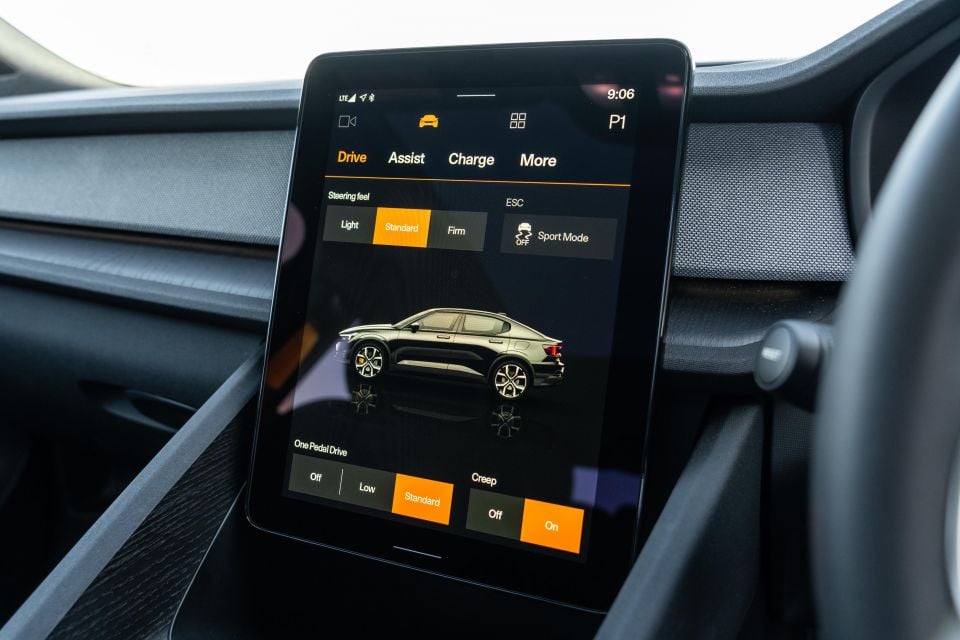
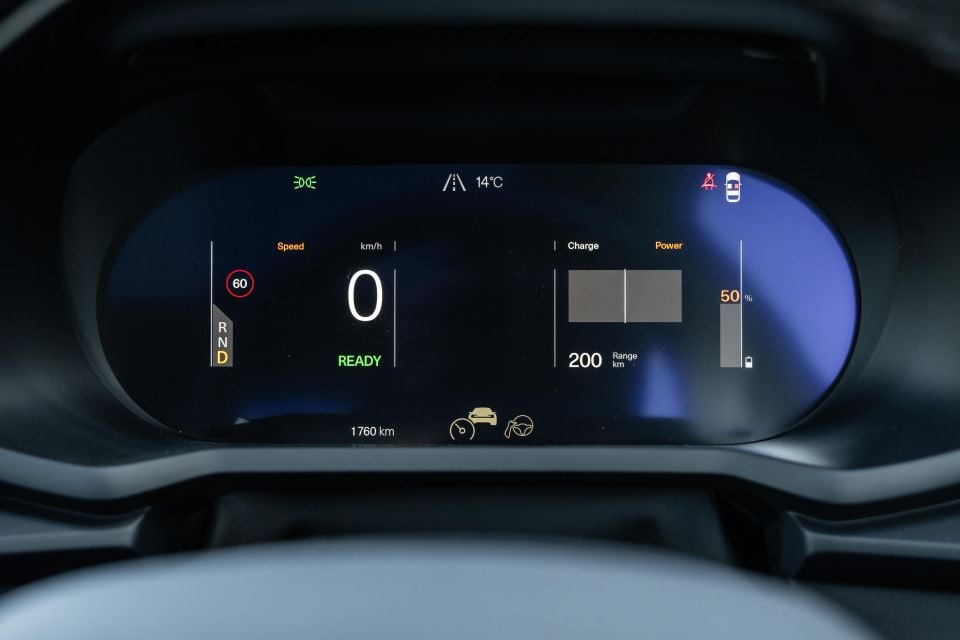
The touchscreen itself offers good resolution and decent response to inputs, though we encountered moments when the system would lag and occasionally I couldn’t use the steering wheel controls to skip songs when connected to Apple CarPlay; requiring me to disconnect and re-connect my iPhone 14 Pro Max at the next opportunity to stop.
Running Google’s Android Automotive software means you have a connected infotainment system right out of the box, allowing for “Hey Google” voice prompts to use the Google Assistant, connected navigation by way of Google Maps, and connectivity with online streaming services like Spotify. It’ll even read out your text messages and let you respond using voice inputs.
I find the Volvo interface a little more sophisticated if convoluted, however, and it’s a shame there’s no wireless smartphone mirroring yet. The optional 13-speaker Harman Kardon audio offers good sound though, but I’d love to have seen the excellent Bowers and Wilkins premium audio available in most Volvos offered here.
The lack of physical climate controls grates somewhat as well, even if the touchscreen-based toggles are more intuitive than other brands’ implementations. Seat heating, likewise, is controlled via touch. Unlike the Volvo setup, the home button for the infotainment system is also a virtual line at the base of the display, like a smartphone.
There’s no starter button either, instead you just hop in and engage Drive, or conversely press Park and open the door to turn it off. Volvo does a similar thing with the C40 and XC40, and it’s a bit of a love-it-or-hate-it thing.

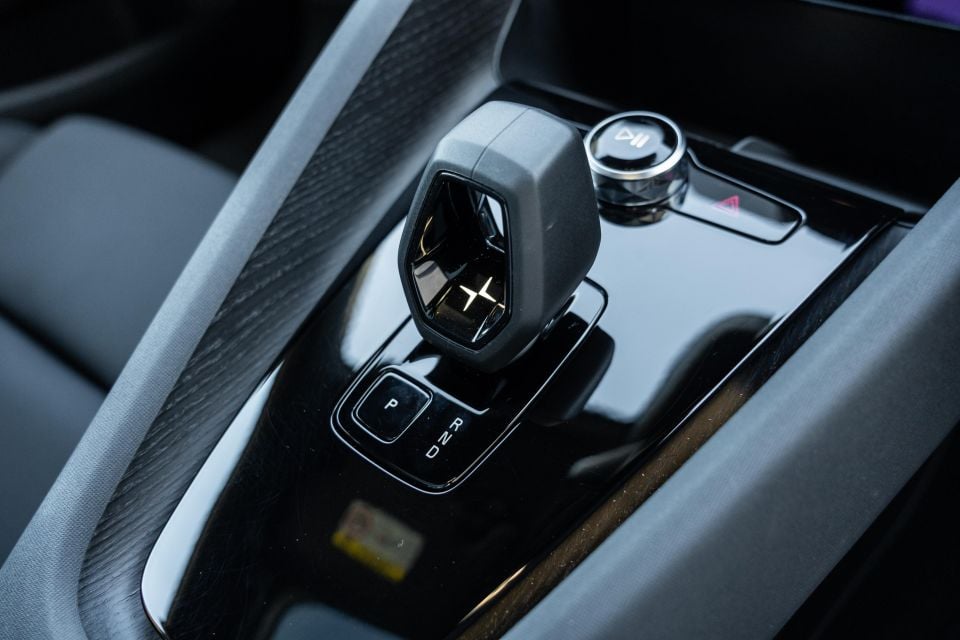
Up front comfort and space is good, with good adjustment in the seats and steering wheel and a nice airy feel aided by the plentiful glasshouse. Our test car’s Plus Pack brings full electric front seat adjustment with memory – instead of partial electric adjustment for the base spec – as well as the fixed panoramic sunroof.
Said glass has no shade, and while tinted you can feel the heat radiating off the glass in direct sunlight.
Likewise, storage leaves a bit to be desired too. There’s one main cup holder between the front seats, with an additional one hidden under the front-centre armrest. The door bins are an ok size, but nothing to write home about.
At least it offers pretty good build quality, even if some of the materials are easy to mark and scuff. Our tester was specified with the Slate-coloured WeaveTech vegan and water-resistant upholstery combined with Black Ash wood-look trim inlays. WeaveTech a comfortable and pliable material if not super breathable – back sweaters beware.
One highlight for me, if a bit trivial, is the Swedish Gold seatbelt finish. Call me basic or tasteless but I love the pop of colour that’s distinctly different to anything else available on the market right now.
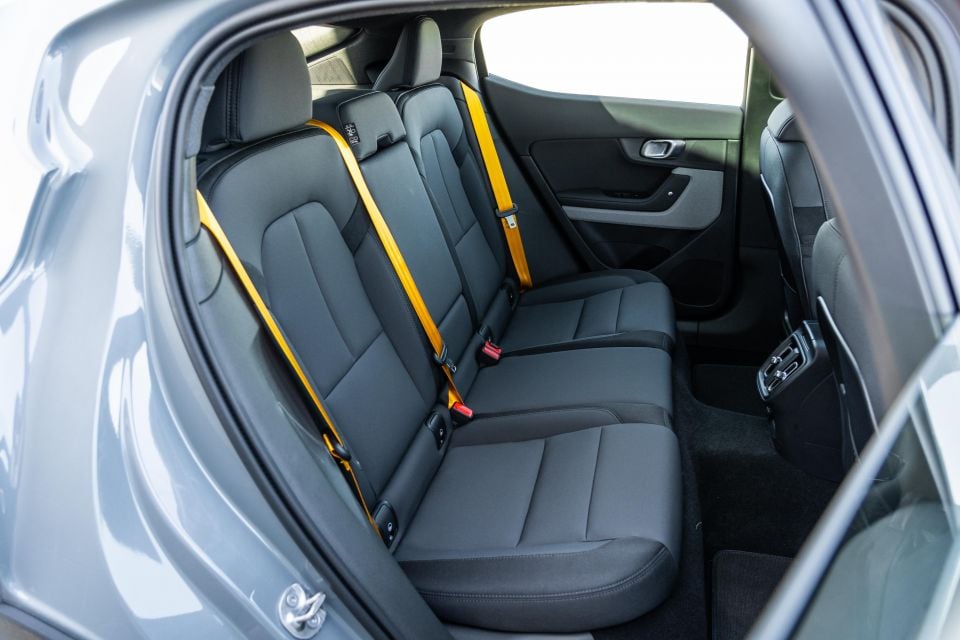
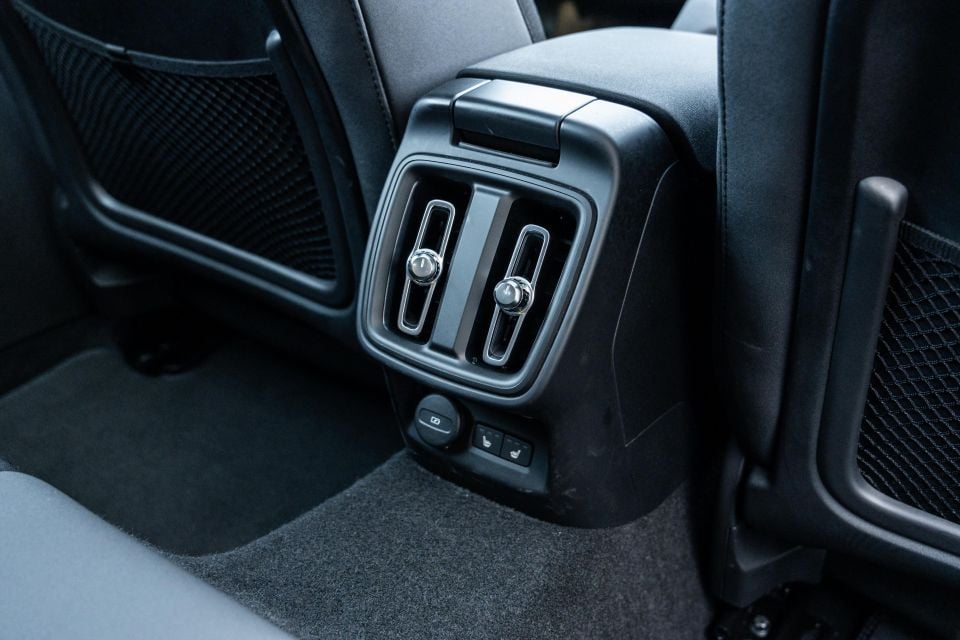
Hop into the rear and it’s a bit of a mixed bag. If you’re a taller person like me (6’1) sitting behind a taller driver, second-row passenger accommodation is cosy at best. That said, the Tesla Model 3 is similarly tight in the second row.
Main issues are a lack of knee room for leggy people like myself, though despite the optional fixed glass roof headroom isn’t that compromised. Foot space is also compromised by the large centre hump despite the lack of a centre driveline, a product of its ICE-based architecture.
The Swedish Gold seatbelts continue into the rear, and amenities include rear air vents, map pockets behind the front seatbacks and two USB-C charge ports at the rear of the centre console. There’s also a fold-down centre armrest with cupholders.
For the kidlets, there are ISOFIX and top-tether anchors in the rear, though not the quirky built-in booster seat you’ll find in numerous Volvos.
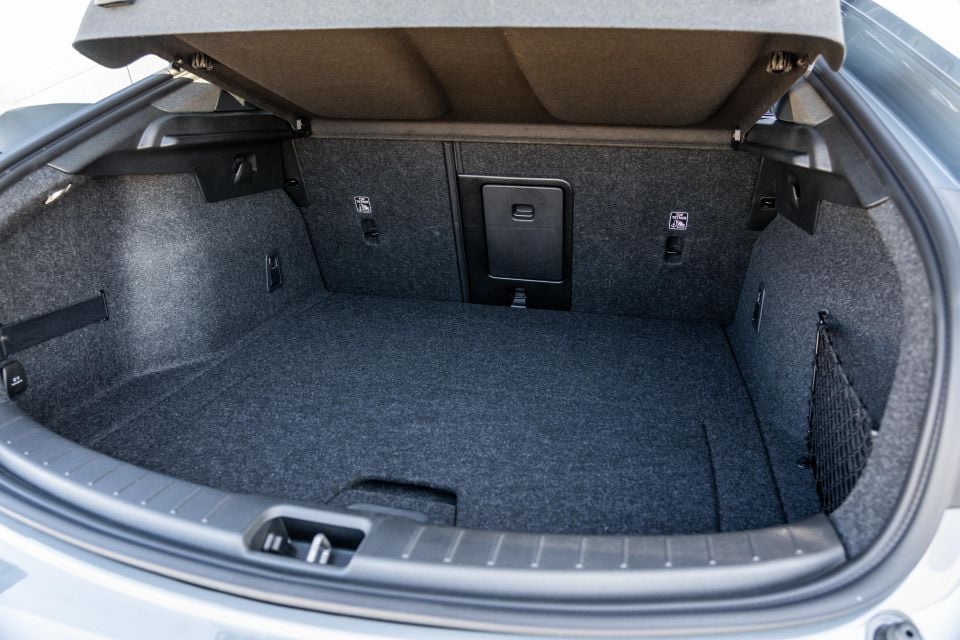
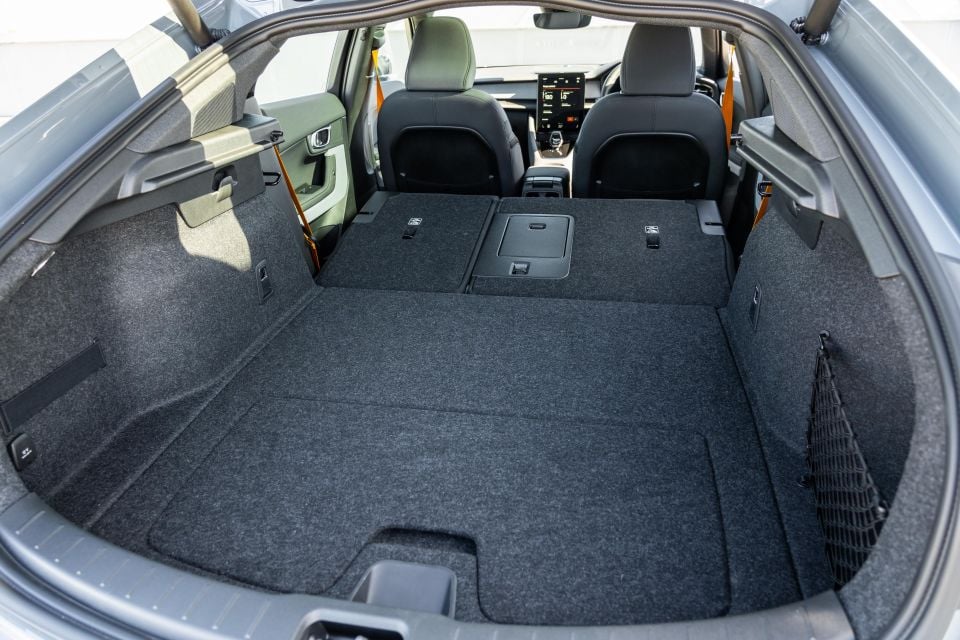
Behind the 60:40-split second row is a 405-litre boot, accessed via the liftback tailgate. By comparison, a Tesla Model 3 offers 425L.
It’s got a handy adjustable floor that can compartmentalise the area, and the space itself is nice and square, if a bit shallow.
There’s a ski port for stowing longer items, and there’s netting and an elastic strap to hold smaller things in place.
Up front there’s also a 50-litre ‘frunk’, which is good for storing cables or other items that you want out of sight, but again it’s trumped by the Model 3 for volume (224L).
We have the Long Range Dual Motor on test here, which is the most powerful variant available.
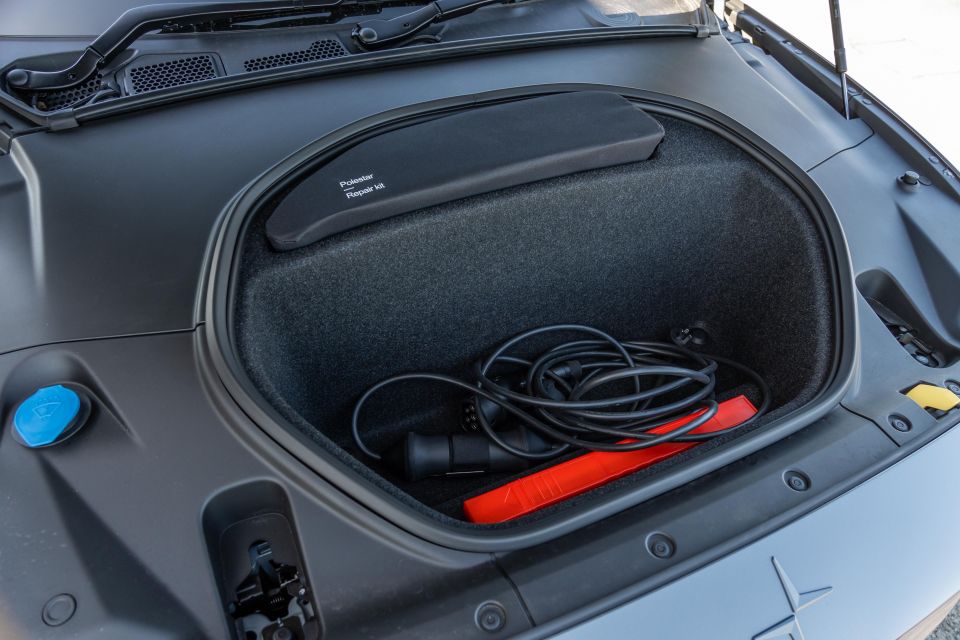
A pair of electric motors – one on each axle – combine to output 300kW of power and 660Nm of torque, as well as facilitating all-wheel drive.
Polestar claims the flagship 2 can accelerate from 0-100km/h in just 4.7 seconds, on its way to a top speed of 205km/h. Customers can also add a performance software upgrade to the Dual Motor variant for $1600, which bumps outputs by 50kW and 20Nm (350kW/680Nm) and drops the 0-100 claim by 0.3 seconds (4.4s).
The aforementioned pair of e-motors are hooked up to a 78kWh lithium-ion battery, good for a claimed driving range of 487 kilometres on the combined WLTP cycle. The Long Range Dual Motor quotes a combined energy efficiency rating of 19.4kWh per 100km.
It can be charged at a rate of up to 155kW at a DC fast charger, which can replenish the battery from 10 to 80 per cent in as little as 35 minutes. Using an AC three-phase 16A home wallbox, Polestar claims a charge time of 8.0 hours for the Long Range battery.
For those who tow, the Polestar 2 is rated to haul up to 1500kg braked.
If you’ve driven the Volvo C40 or XC40 Recharge EVs, then it sort of feels like a low-slung version of those.
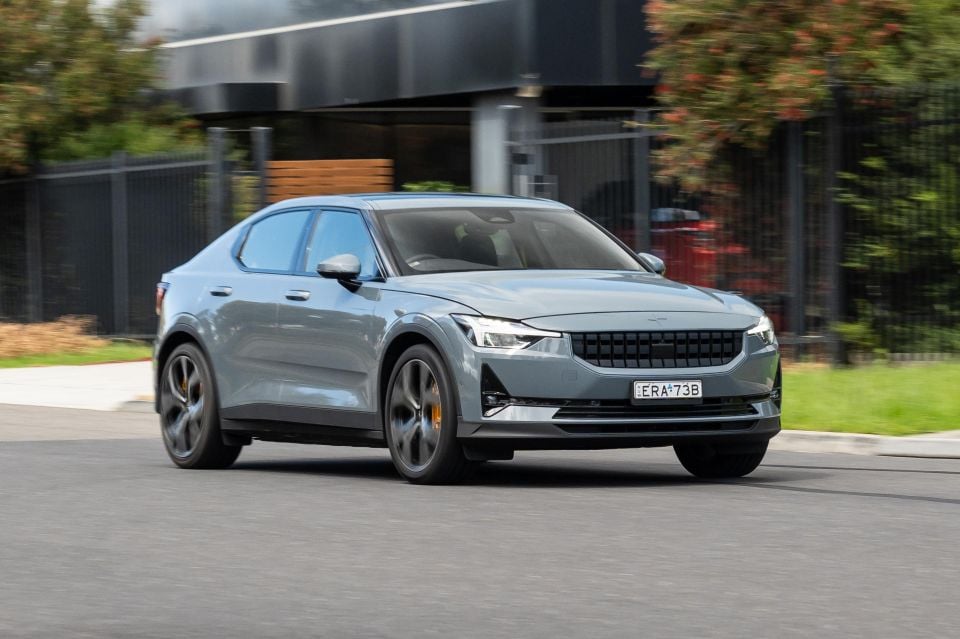
Sharing its Compact Modular Architecture (CMA) with said Volvo models, as well as looking and feeling very much like a Volvo inside and out, the Polestar 2 will be nicely familiar for those who enjoy the Swedish brand’s models.
There’s a solid, sure-footed feel at all speeds, and despite our test car’s array of performance-focused options, the Polestar’s handling isn’t necessarily geared towards tearing up tight B-roads – it feels a little heavy for that.
With a base kerb weight of 2113kg, the Polestar 2 gives off grand tourer vibes than rather than feeling like a BMW 3 Series sports sedan. For reference, a Tesla Model 3 Performance quotes a tare mass of 1844kg – 273kg less than the chonky Polestar.
As we’ve experienced with CMA-based EVs in the past, performance in normal driving may feel a bit dulled at first, given the long throttle pedal travel in the standard drive mode which takes a bit of getting used to.
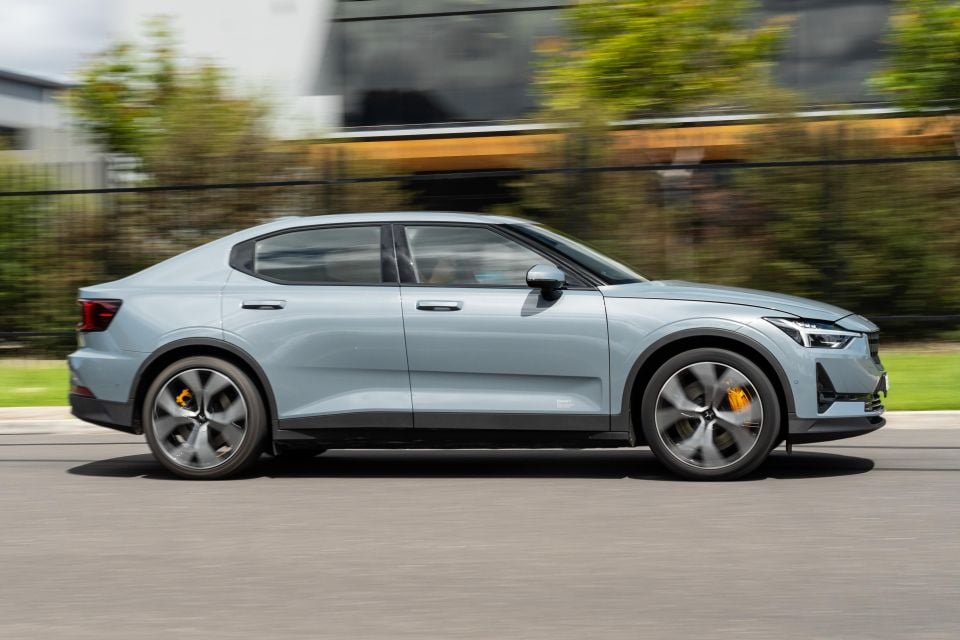
It stops you from accidentally doing a full send in a suburban street, however, some may find it to feel laggy and unresponsive unless you really stab it.
When do you do really stab it though, the Polestar 2 rockets along with that instant torque response we’ve become accustomed to with high-performance EVs, and the dual-motor AWD powertrain gets its immense grunt to the ground without putting a toe – or tyre – out of line.
And, it does this all in relative silence, save for the faint whirr from the e-motors underneath.
Steering response feels very Volvo, in that it’s a little on the heavier side but still nicely accurate if a little devoid of feel. It’s another reason why the Polestar 2 doesn’t feel particularly sporty, despite its impressive straight-line performance.
You’re also dealing with a heavy car in general, and you can feel the weight shift as you tackle faster corners.
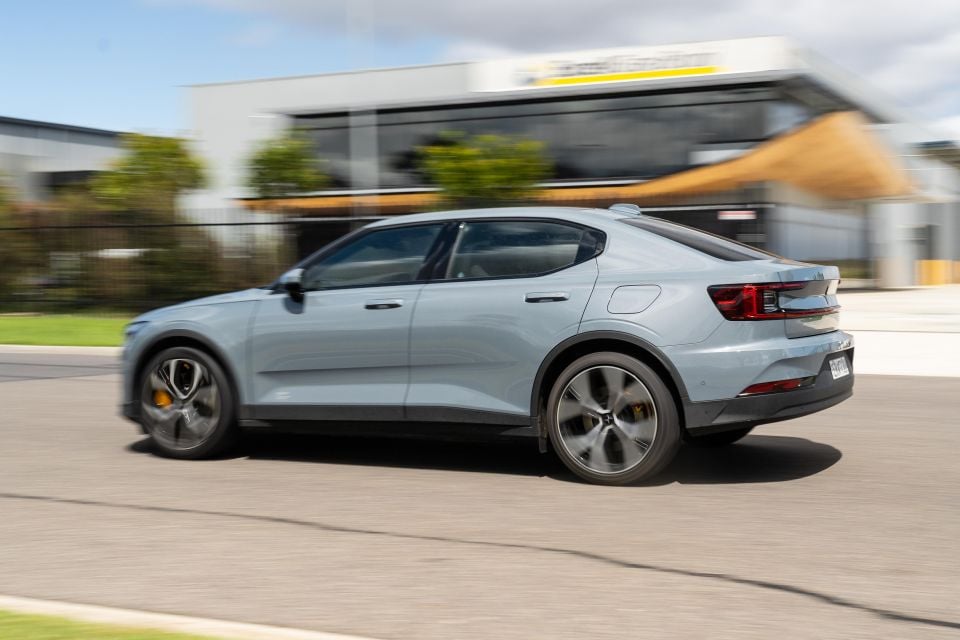
Our test car’s optional Öhlins Dual Flow Valve (DFV) dampers aren’t electronically-controlled adaptive units, but offer 22 different suspension settings, adjusted manually like performance coilovers. You can do this yourself or have it done at a Polestar service point – you get one free adjustment with purchase.
The vehicle we tested was clearly in a more balanced setting, as while erring on the side of firm still did a reasonable job of ironing out the lumps and bumps of Melbourne’s urban and city roads. I was actually impressed.
From a refinement perspective, the Polestar 2 did a decent job of keeping road and wind noise at bay, but sampling this Performance-spec Dual Motor back-to-back with a standard Single Motor with smaller wheels demonstrated the impact the 20-inch wheels and 245/40 Continental SportContact 6 performance tyres have on interior refinement.
The upgraded Brembo brakes of the Performance Pack provide good stopping power too, but in normal driving you’re rarely going to have to call upon the enhanced capability of the Swedish Gold-painted, four-piston calipers and cross-drilled discs (versus the two-piston standard units). I spent most of my time with the car using the one-pedal driving mode.
Overall it’s a pretty agreeable thing to drive daily even in this more focused specification, though you’d probably be better off not ticking the Performance Pack box and pocketing the cash unless you really love the look.
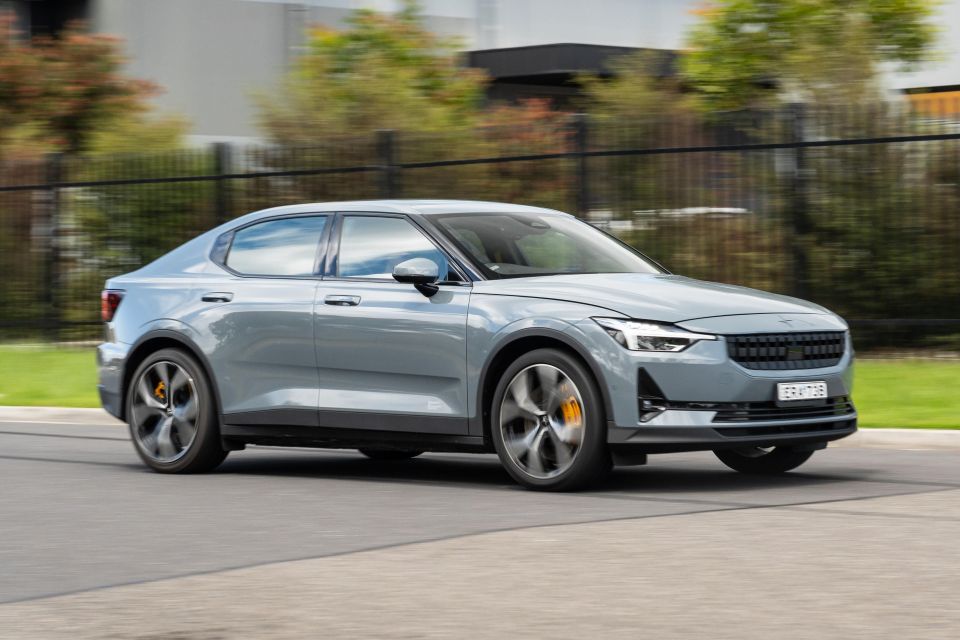
Where expert car reviews meet expert car buying – CarExpert gives you trusted advice, personalised service and real savings on your next new car.
Our test vehicle was also specified with the Pilot Lite Pack, meaning it featured the full suite of assistance features available.
As we’ve come to expect from Volvo products, the Pilot Assist semi-autonomous highway assistant worked pretty well, though at times I felt it wasn’t doing the best job at following curves on Melbourne’s M3 Eastern Freeway. Further, I had a couple of occasions where it phantom braked even if there wasn’t another vehicle leading ahead.
Blind-spot and rear cross-traffic assists work as you’d expect and are good to have – though I’d argue like adaptive cruise they should be standard at this price point – while the 360-degree parking camera brings a welcome bump to visibility when parking this boxy sedan, though the ultra-wide viewing angles can distort the picture on the upright infotainment display – I have the same issue with Volvos, if that matters.
For the time being, we also no longer get Pixel LED matrix-style headlights with the Pilot Pack, hence the Lite tag. Given our test car is over $90,000, it’s a bit disappointing to not have this headlight technology available given you can get Matrix LEDs standard on a Volkswagen Polo. You do get auto high-beam, though.
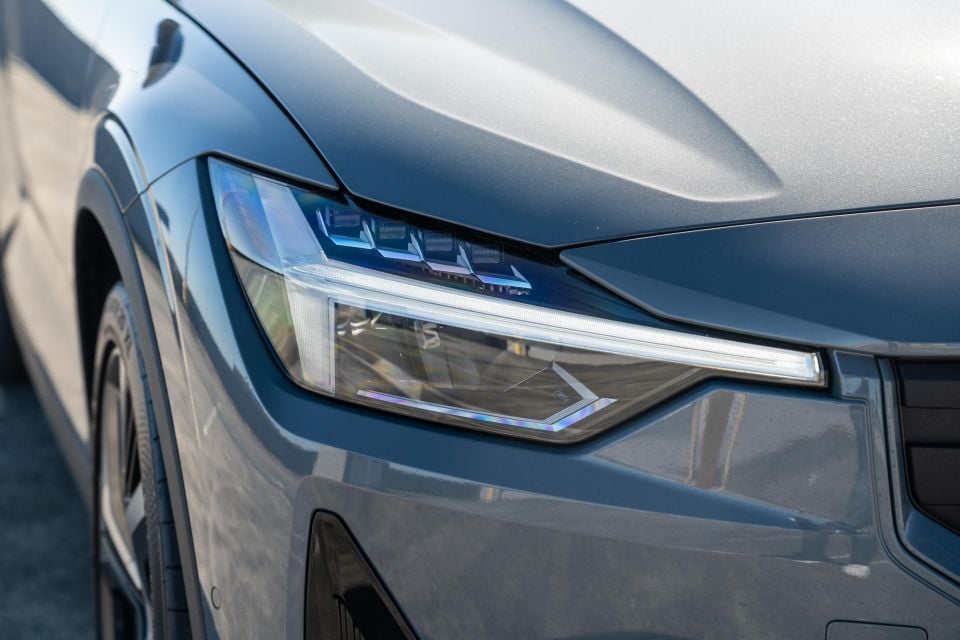

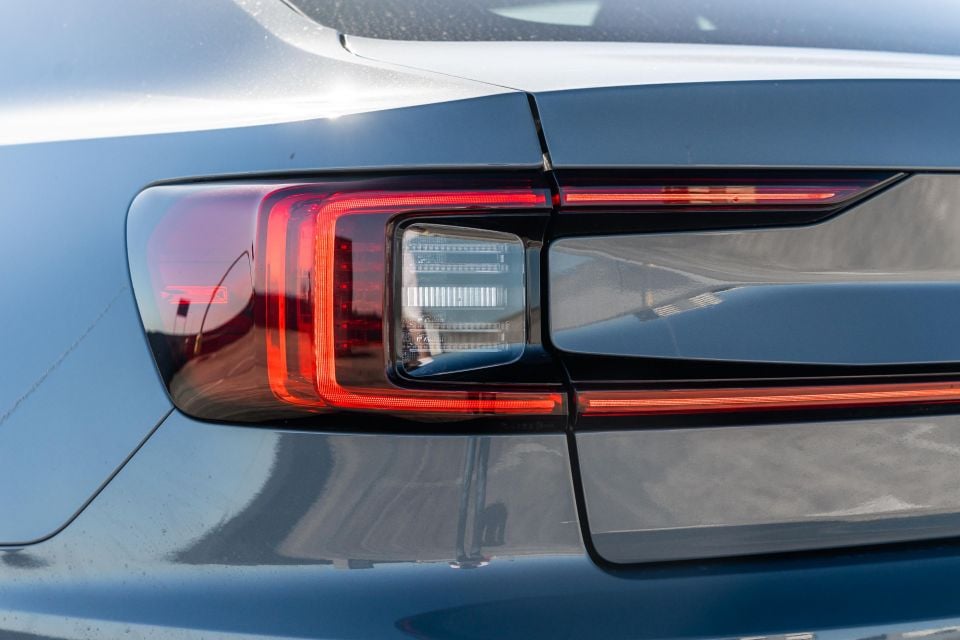

Polestar 2 highlights:
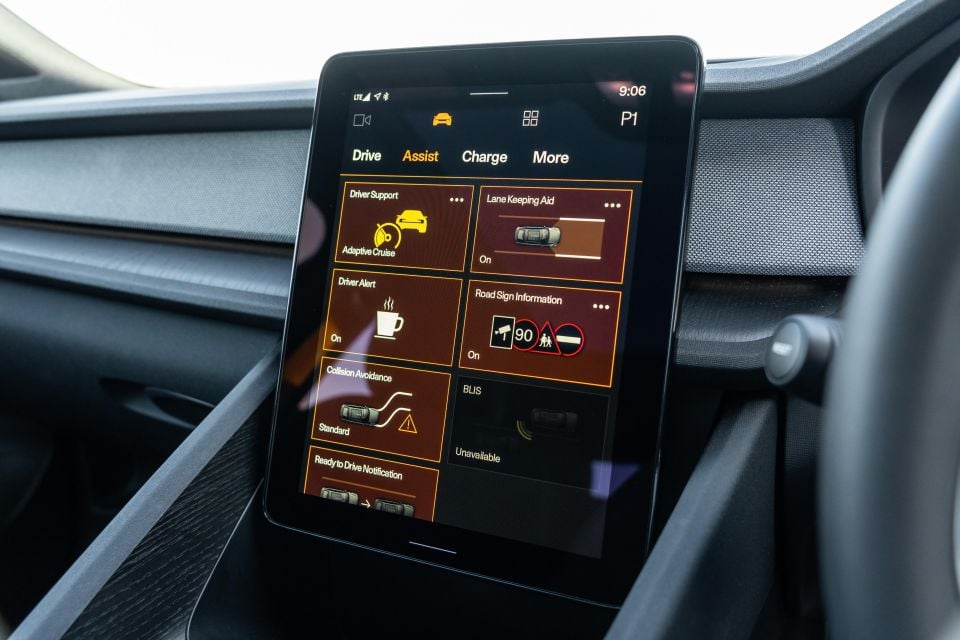
Pilot Lite Pack: $3400
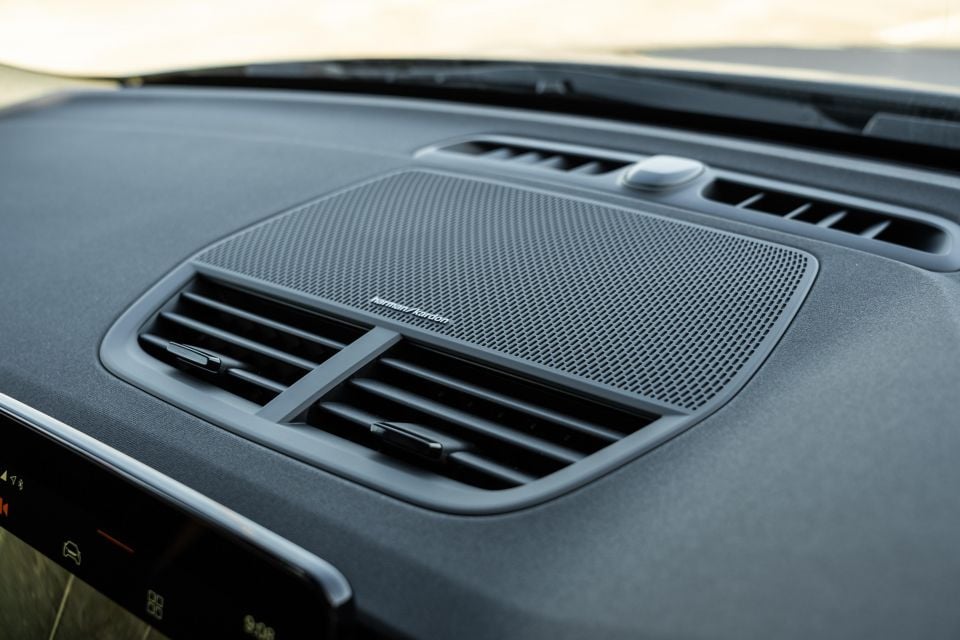
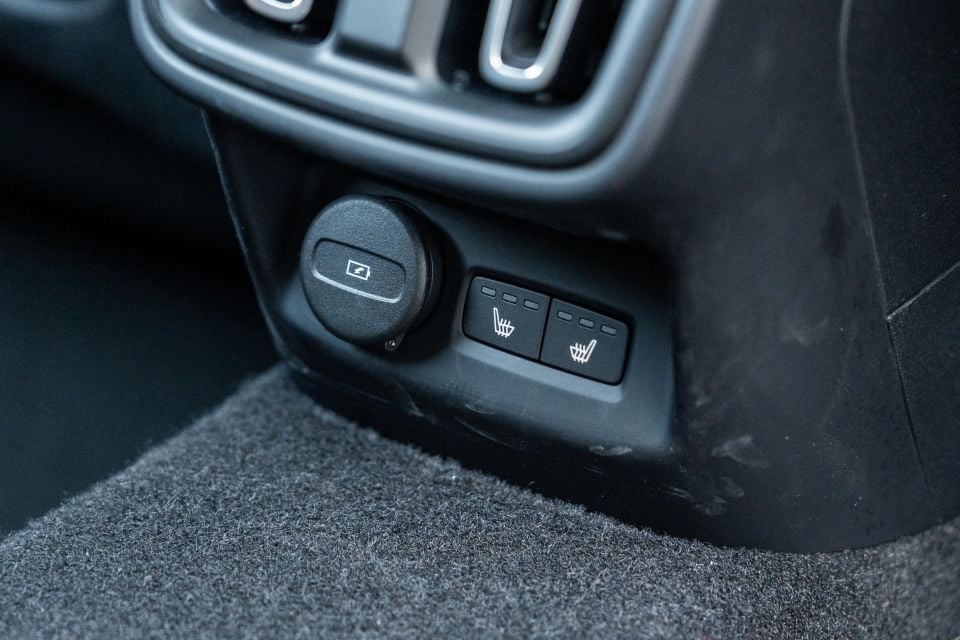
Plus Pack: $6000
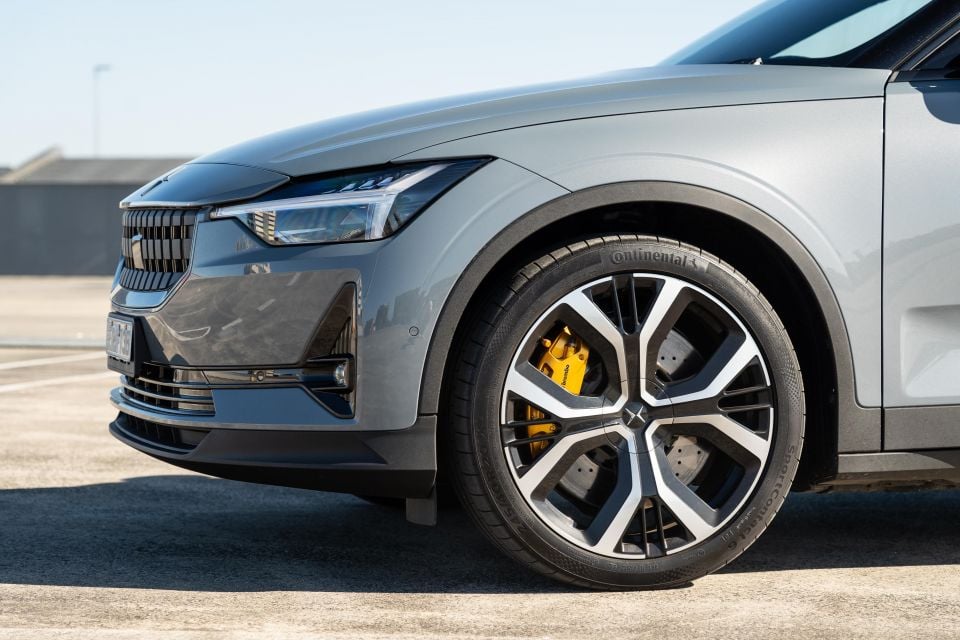

Performance Pack: $8000 (Long Range Dual Motor)
The Polestar 2 has a five-star ANCAP safety rating with 2021 date stamp.
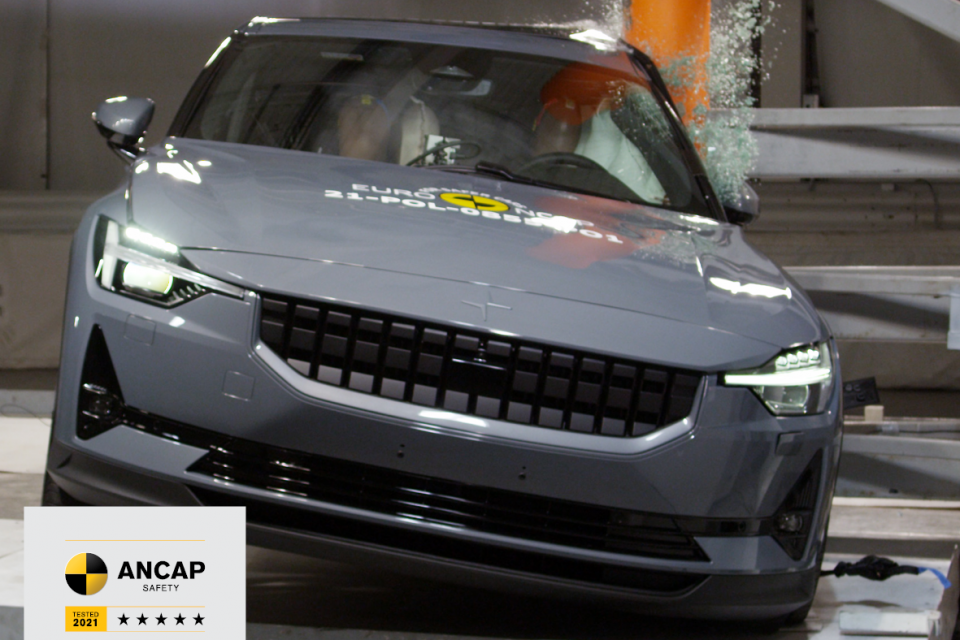
It received an adult occupant protection score of 93 per cent, a child occupant protection score of 89 per cent, a vulnerable road user protection score of 80 per cent, and a safety assist score of 86 per cent.
Standard safety equipment includes:
Annoyingly, to get features like adaptive cruise control with semi-autonomous highway assist, blind-spot assist and rear cross-traffic assist, you have to spend $3400 to add the Pilot Lite pack which also brings LED front fog lights, side parking sensors and a 360-degree parking camera.
The Polestar 2 is covered by a five-year, unlimited-kilometre warranty, as well as an eight-year, 160,000km battery warranty. All versions also come with free servicing and roadside assistance for five years.

The service plan covers up to 100,000 kilometres, and represents a not-insignificant saving compared to some other manufacturers that can charge anywhere between $1500 and $3000 for five years of maintenance.
Unlike some premium competitors, however, Polestar doesn’t throw in a complimentary subscription to the Chargefox public charger network, nor does it seem to offer a home charger installation solution.
As a guide for running costs, I took the Polestar 2 to the Ultra Fast 350kW DC charger at Airport West in north-west Melbourne, and recharged 59.98kWh in 55 minutes for $35.99; charged at a rate of $0.40 per kWh. I saw the charge speed peak around the 130kW mark, a little down on the quote 155kW peak.
Over 440 kilometres during a week of testing in mixed conditions, I saw an indicated efficiency rate of 20.1kWh per 100km, against the manufacturer’s 19.4kWh/100km claim. Not bad, but a bit up on what you’ll get out of a Model 3 Performance (approx. 16.3kWh/100km).
That energy consumption would indicate to a real-world range of just under 400km, which is quite a bit off Polestar’s 487km claim.
The Polestar 2 is an EV for those that want something that looks and feels like a ‘normal’ car, and that appeals to me.
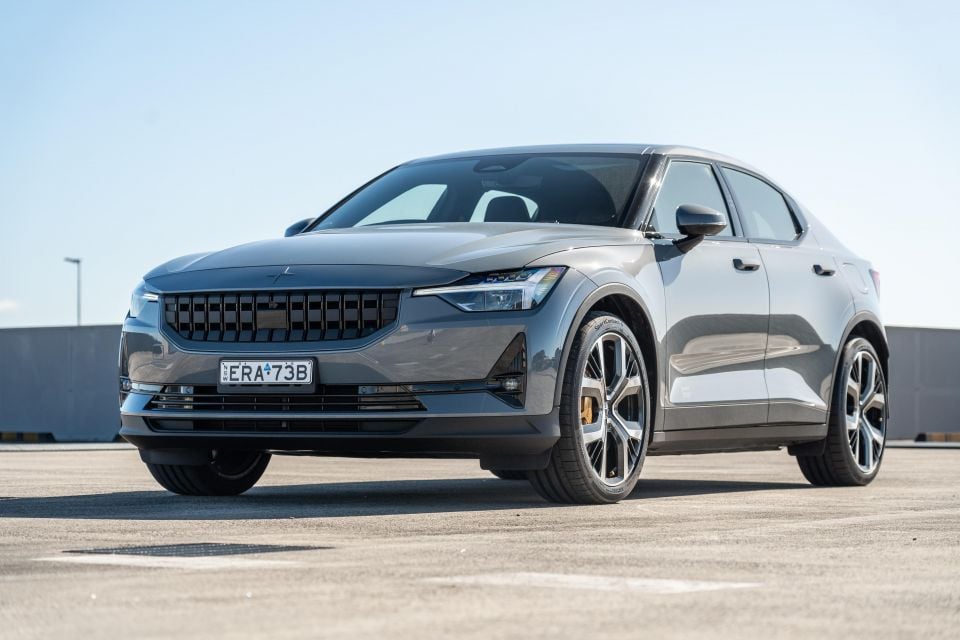
While devoid of Volvo badging, the Chinese-made sedan looks and feels like an electric modern take on the Volvo S40 of decades past, and has a pleasant air of familiarity about it while also being a bespoke design in the Volvo/Polestar stable. If you want an EV but can’t stomach a Tesla, this is probably the closest thing to a Model 3 available right now.
In Long Range Dual Motor guise, it’s silly quick despite not being able to match a Model 3 Performance, offers decent range (at least on paper), looks the goods with its gold-themed Performance Pack, and has a well-built cabin. It also offers a competitive aftersales package, giving peace of mind for the at least the first five years of ownership.
However, ticking options becomes a pricey exercise, and it’s one of the less efficient EVs of its size and body type which leads to a less impressive driving range going by our achieved energy consumption figures.

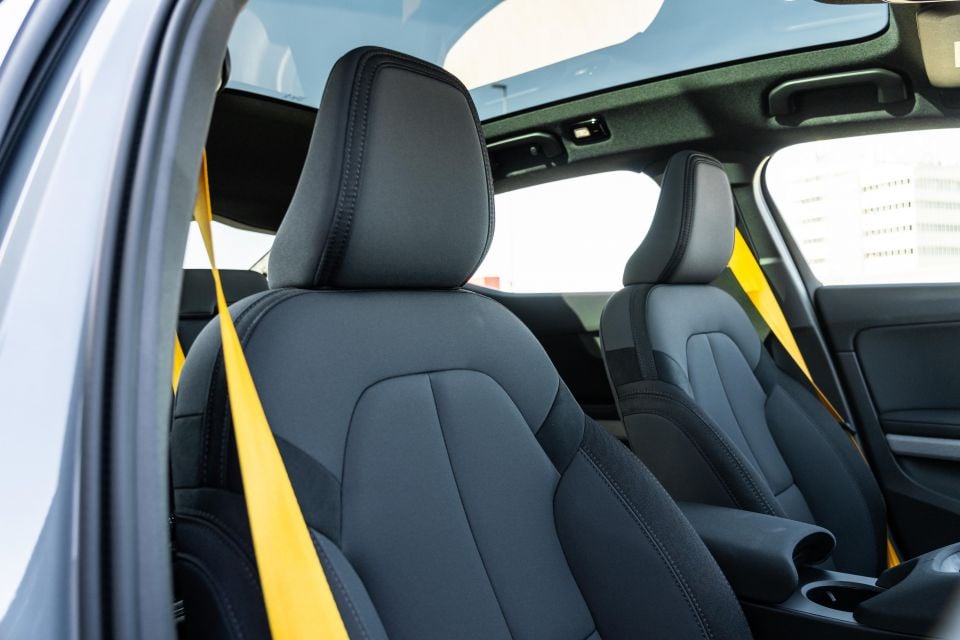
Additionally, the rear seat is a bit cramped for knee room and foot room, and cargo capacity isn’t great for the class, largely due to aspects carried over from its ICE platform.
Personally, my pick of the Polestar 2 range is the mid-spec Long Range Single Motor, which can theoretically travel over 550 kilometres between charges, and is a whole $5000 cheaper than the Dual Motor model on test.
If you want the performance of the Dual Motor but also want the best-value spec, don’t tick the $8000 Performance Pack as in real-world terms you’re unlikely to really want or need any of the go-fast add ons, as nice as they may look.
All told the Polestar 2 remains a solid contender in the compact EV market. It’s more conventionally understated than most ground-up EVs, drives well, offers a good range of variants, and represents decent value if you’re smart with options. Then again, the related XC40 Recharge offers the same drivetrain, more space and more features for less.
Click the images for the full gallery
MORE: Everything Polestar 2
Where expert car reviews meet expert car buying – CarExpert gives you trusted advice, personalised service and real savings on your next new car.
James Wong is an automotive journalist and former PR consultant, recognised among Australia’s most prolific motoring writers.


Damion Smy
7 Hours Ago


Damion Smy
8 Hours Ago


Damion Smy
10 Hours Ago


Damion Smy
11 Hours Ago


Damion Smy
13 Hours Ago


Damion Smy
14 Hours Ago